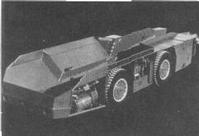


Chapter 11
I The Present Energy Economy
II Australian Energy Consumption
III Research And Development
IV Coal
i Transition at the coal face
ii Further development of face mechanisation
iii Mechanisation outside the face area
iv Open-cut mining in NSW
v Open-cut mining in Queensland
vi Underground mining in Queensland
vii The state of the art
viii Conclusion
V Oil And Natural Gas
VI Solar Energy
VII Nuclear Energy
VIII Bagasse Firewood And Other Biomass
IX Electric Power Generation And Distribution electric Power Generation And Distribution
X Manufactured Gas
XI Industrial Process Heat
Sources
Index
Search
Help
Contact us

Open-cut mining in NSW
No doubt prompted by the necessity to obtain coal for industrial purposes during the Second World War, open-cut mining began in the Western district at Lidsdale, where, under shallow cover, the Lidsdale split of the Lithgow seam was worked in 1940 and spread gradually in that district and also to the Muswellbrook area. The Joint Coal Board report of 1947-48 indicated that prior to 1947 1.608 million tonnes of coal were mined in this manner or at the average rate of 0.241 million tonne/yr. In 1947 coal mined by open-cut was 0.959 million tonne/yr and exploration was directed to coal at shallow depths suitable for this purpose so that by 1951 20 million tonnes were classified as proved resources. In 1985-86 the measured and indicated reserves -in situ (raw coal) -is given as open-cut 3.071 million tonnes.
The slow emergence of open-cut operations, although shallow coal was known to exist, was no doubt partly due to the fact that the type of equipment suitable to these operations was not available but it was also due to a form of blinkered vision in regard to shafts which were sunk instead of tunnels to very shallow coal measures.
The first attempts to fit the equipment to the task were taken in 1948, when orders were placed by the Joint Coal Board for five two and a half yard shovels and one two and a half yard dragline. Development on a planned basis continued, so that in 1951 three 12 yard walking draglines were in operation, with matching auxiliary equipment. In 1951 open-cuts were producing 1.811 million tonnes of raw coal for the calendar year. About this time underground production was catching up and the open-cuts were used as regulators at about one million tonnes per year until 1966 and then steadily rose to 19.03 million tonnes in 1982 and now the figure is 32.26 million tonnes.
Open-cut mining can be broadly classified as strip mining or open-cast in which the prime mover of overburden is a walking dragline and coal is removed by truck and shovel. Actual operations are carried out over long distances on the strike line and are more suited to single gently dipping seams.
Open-pit mining, which generally refers to non-drag-line mines are more likely to resemble quarries with multiple benching and are predominantly worked by shovel and truck methods, operating to exploit more than one seam with steeper dipping characteristics than is usual with drag lines.
With the exception of the walking dragline, however, the auxiliary equipment, drilling rigs, shovels, trucks, etc., is common to both methods and has evolved on the basis that these are more powerful, speedier and of increasing capacity.
To illustrate this, a list of the major pieces of equipment in operation prior to 1950 is as followers:
- Draglines
- two and a half cubic yards
- Shovels
- two and a half cubic yards
- Heavy Excavators
- one and three quarters to three and a half cubic yards
- Medium Excavator
- three quarters to one cubic yard.
At the present time the relative capacities of the equipment in use is:
- Draglines
- Common 46 cu m
Largest 60 cu m - Shovels (excavators)
- Range from 14 cu m to 46 cu m
- Bulldozers
- Up to 10 cu m
- Dump trucks
- Max 72 t Range from 77 t
Average around 154 t
Organisations in Australian Science at Work - Joint Coal Board
 |
Australian Academy of Technological Sciences and Engineering |  |
© 1988 Print Edition pages 793 - 794, Online Edition 2000
Published by Australian Science and Technology Heritage Centre, using the Web Academic Resource Publisher
http://www.austehc.unimelb.edu.au/tia/763.html